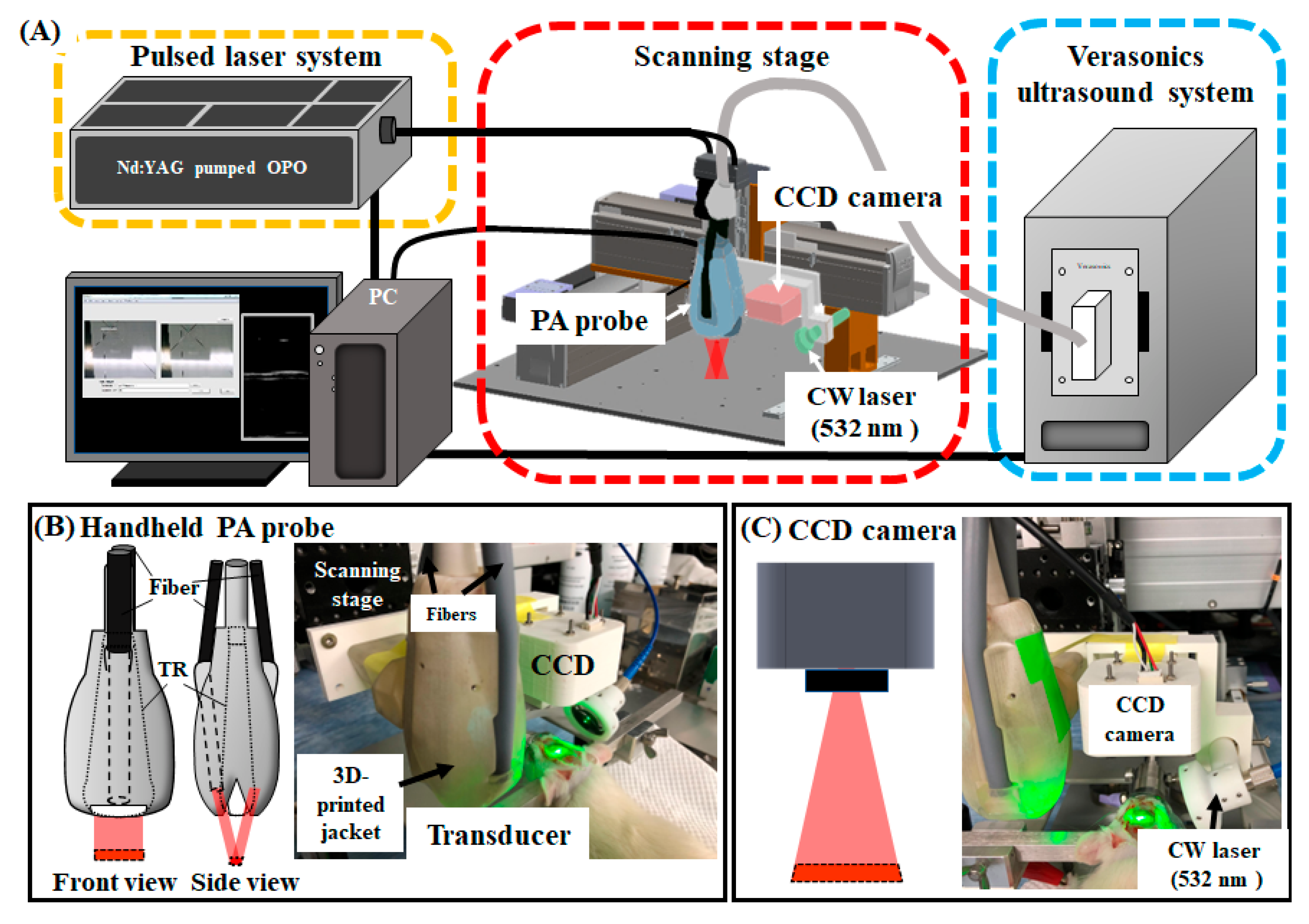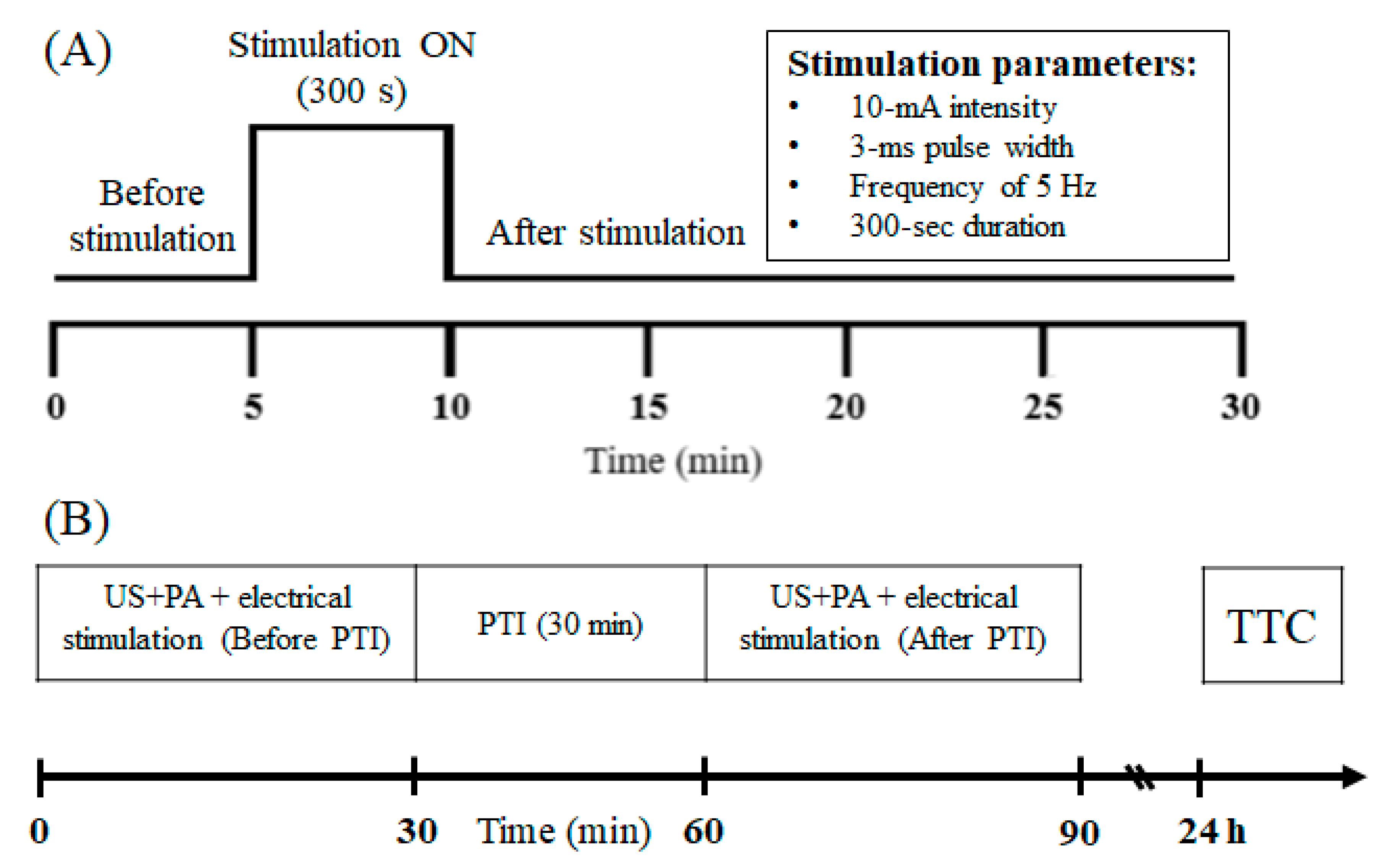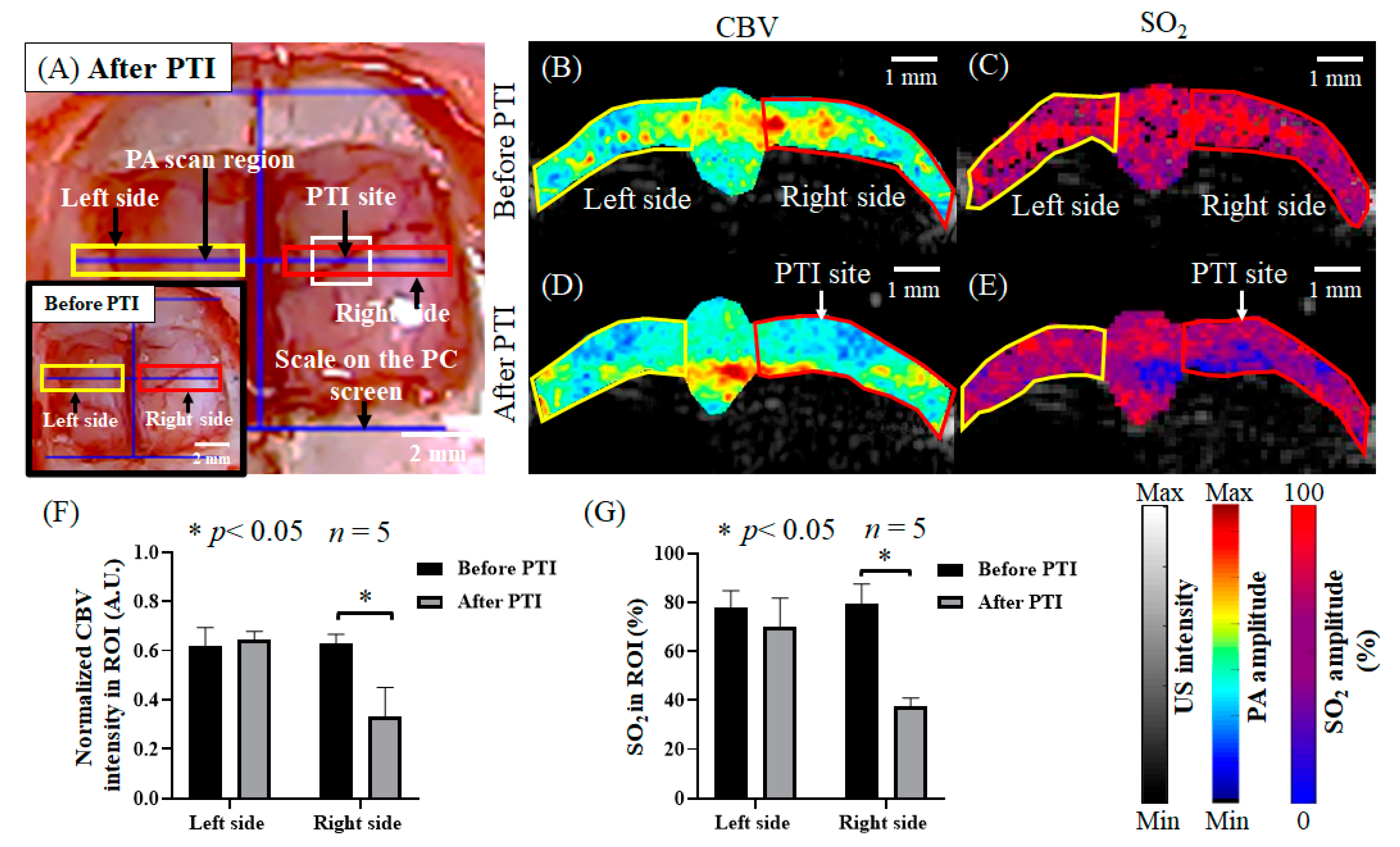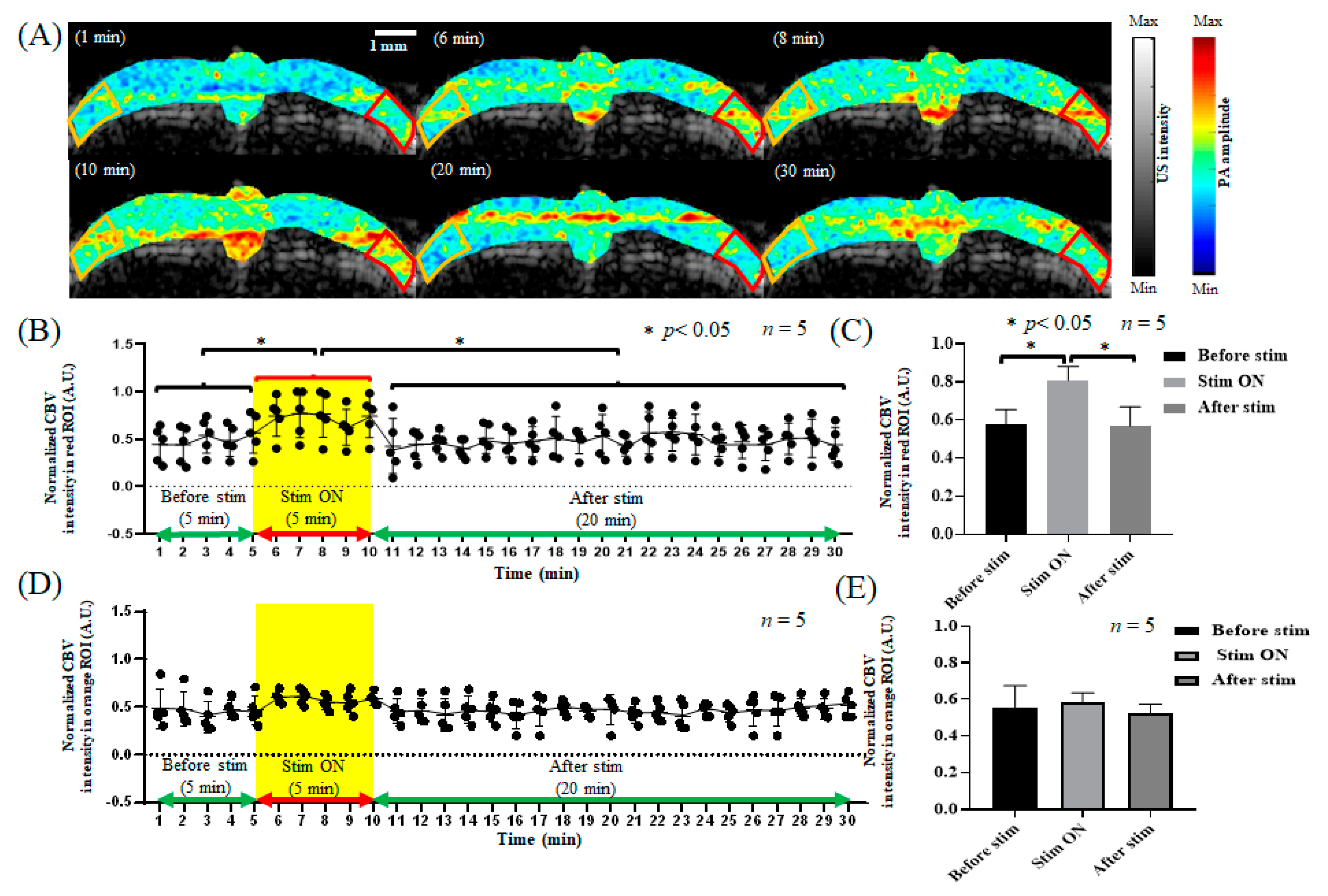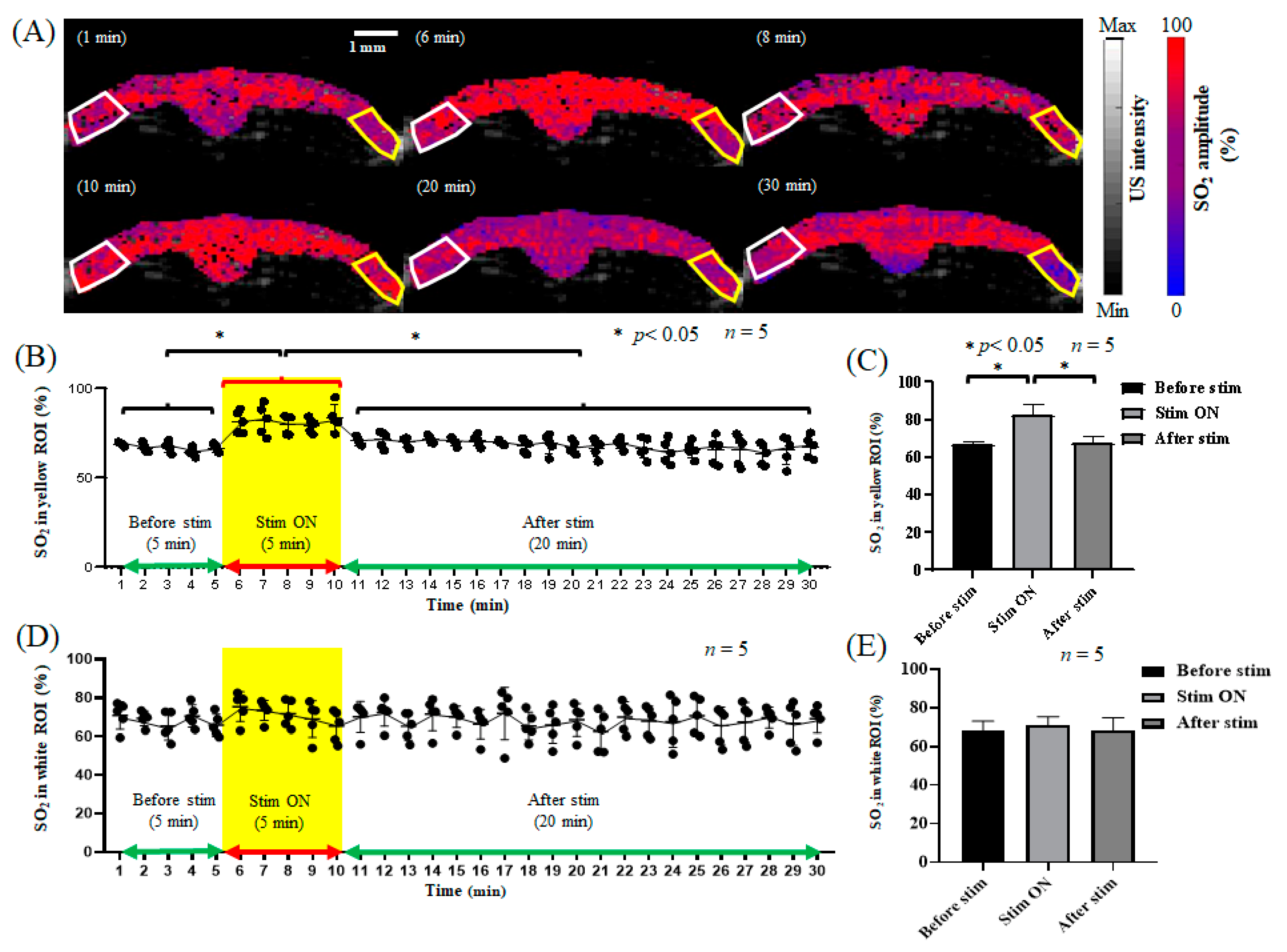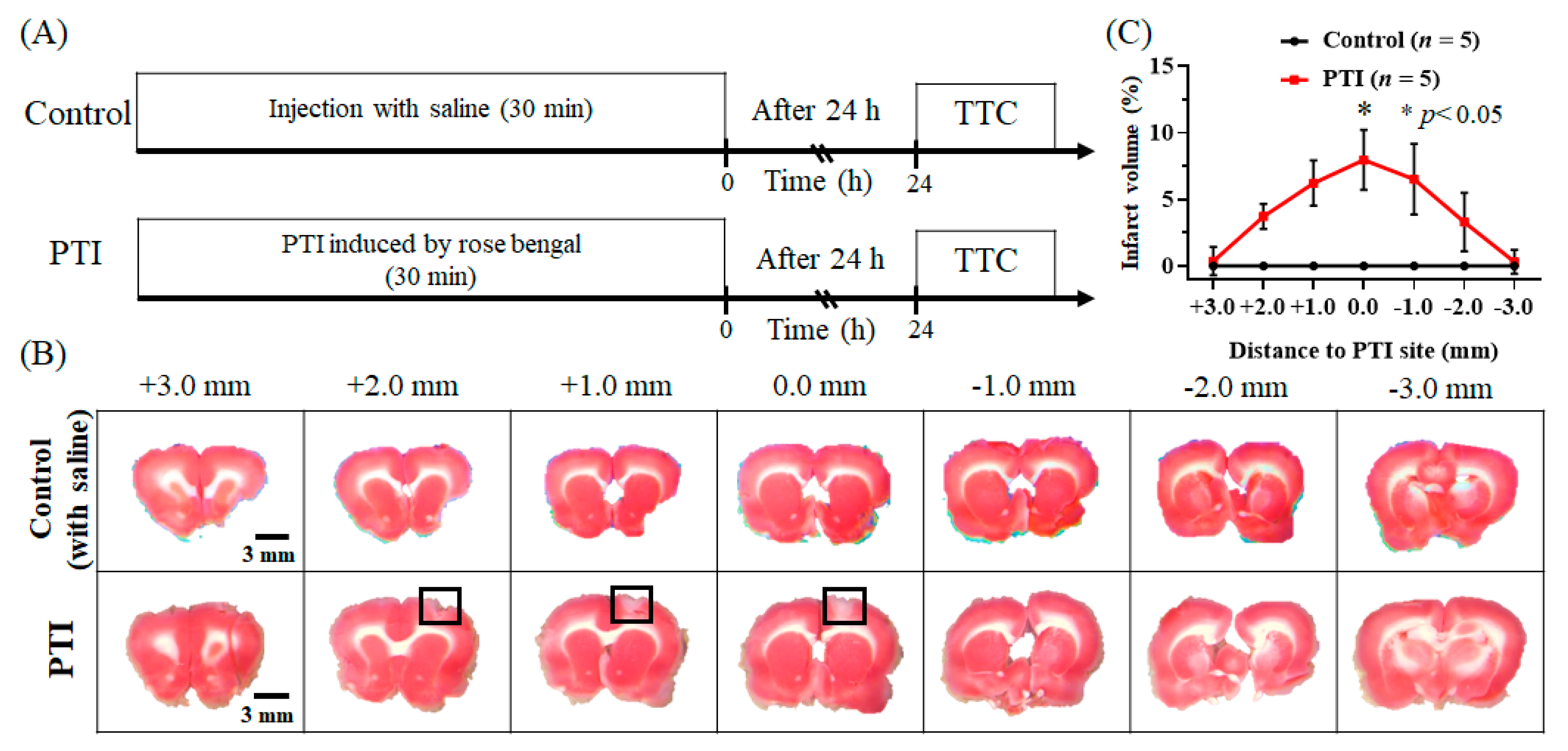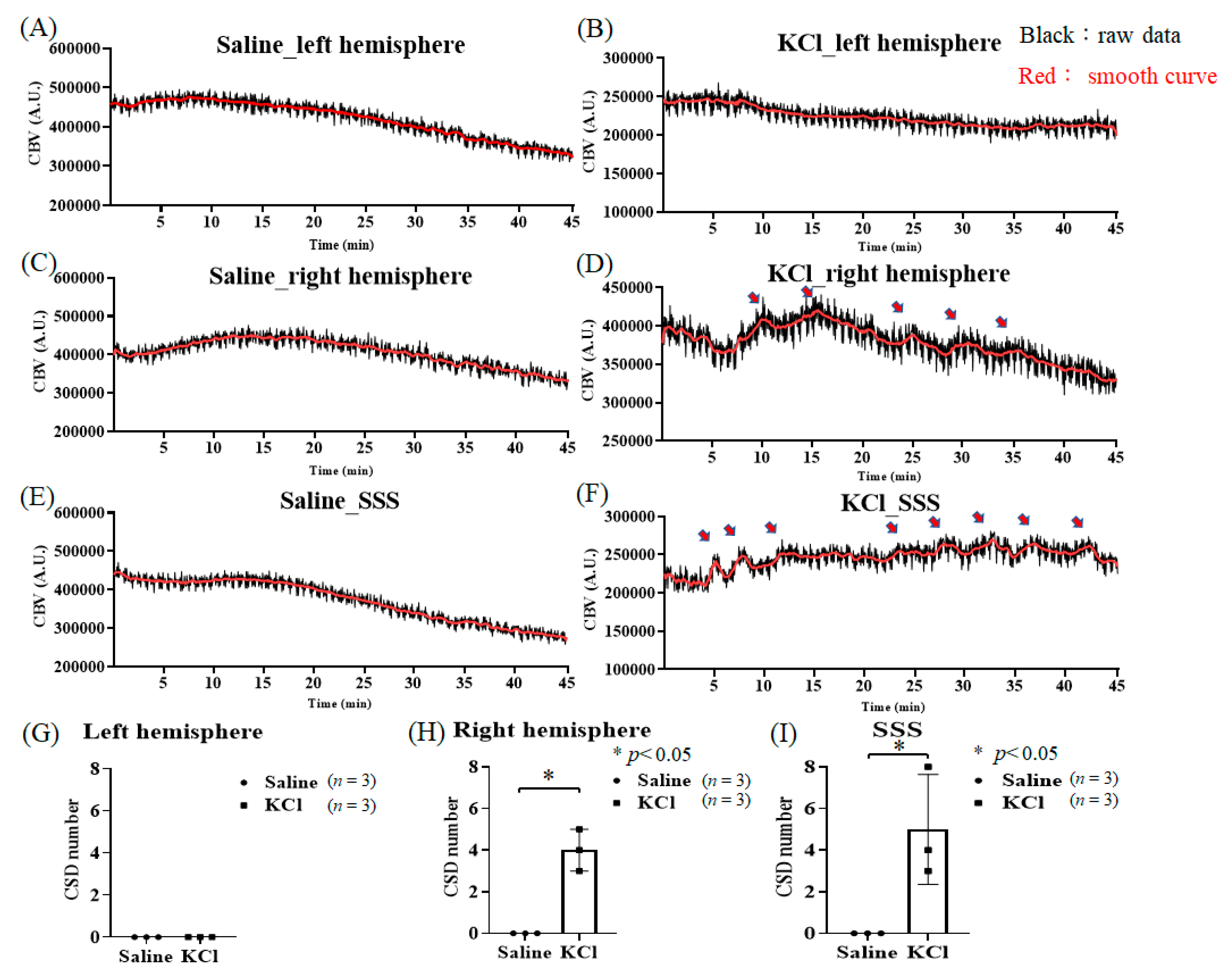Figure 1.
Schematic diagram of the developed dual-modality ViCPAI system with a laser-induced stroke system. (A) Illustration of the proposed ViCPAI system. The laser light source was a Nd:YAG laser with an integrated tunable OPO with light wavelengths ranging from 680 to 2400 nm. The OPO produced approximately 7 ns pulses at a 20 Hz repetition rate. The system included an 18.5 MHz high-frequency planar US probe with 128 channels. The probe received PA signals and transmitted and received US signals. (B) The system included an 18.5 MHz high-frequency planar ultrasonic probe with a 128-channel US platform for data acquisition. The US transducer had 1286 mm active elements and a −6 dB fractional bandwidth of 67%. The system could receive PA signals and transmit and receive US signals. The components were fixed on the same in-house scanning stage using a 3D-printed holder. (C) The PA probe was combined with a CCD camera, and a Sony IMX219 8-megapixel sensor was used as a positioning tool to obtain real-time images. The sensor was 3.674 × 2.760 mm (1/4″ format) and had a 3280 × 2464-pixel resolution for static images. The CCD camera was mounted inside the 3D-printed carrier, and a 3D-printed holder was used to combine the US transducer with the CCD camera carrier. The CCD camera obtained real-time images and aided in precisely positioning the US transducer in the desired ROI. Then, the CW laser-induced PTI stroke and neurovascular activity were observed. (Abbreviations: US, ultrasound; PA, photoacoustic; Nd:YAG, neodymium-doped yttrium aluminum garnet; OPO, optical parametric oscillator; TR, transducer).
Figure 1.
Schematic diagram of the developed dual-modality ViCPAI system with a laser-induced stroke system. (A) Illustration of the proposed ViCPAI system. The laser light source was a Nd:YAG laser with an integrated tunable OPO with light wavelengths ranging from 680 to 2400 nm. The OPO produced approximately 7 ns pulses at a 20 Hz repetition rate. The system included an 18.5 MHz high-frequency planar US probe with 128 channels. The probe received PA signals and transmitted and received US signals. (B) The system included an 18.5 MHz high-frequency planar ultrasonic probe with a 128-channel US platform for data acquisition. The US transducer had 1286 mm active elements and a −6 dB fractional bandwidth of 67%. The system could receive PA signals and transmit and receive US signals. The components were fixed on the same in-house scanning stage using a 3D-printed holder. (C) The PA probe was combined with a CCD camera, and a Sony IMX219 8-megapixel sensor was used as a positioning tool to obtain real-time images. The sensor was 3.674 × 2.760 mm (1/4″ format) and had a 3280 × 2464-pixel resolution for static images. The CCD camera was mounted inside the 3D-printed carrier, and a 3D-printed holder was used to combine the US transducer with the CCD camera carrier. The CCD camera obtained real-time images and aided in precisely positioning the US transducer in the desired ROI. Then, the CW laser-induced PTI stroke and neurovascular activity were observed. (Abbreviations: US, ultrasound; PA, photoacoustic; Nd:YAG, neodymium-doped yttrium aluminum garnet; OPO, optical parametric oscillator; TR, transducer).
![Biosensors 13 00107 g001 Biosensors 13 00107 g001]()
Figure 2.
Protocols for electrical left forelimb stimulation and US/PA scans of selected blood vessel and S1FL regions. (A) PA signals were collected for 30 min. The first 300 s was used to determine the baseline level. Then, a constant 10 mA electrical stimulation with a pulse width of 3 ms was provided at a frequency of 5 Hz for 300 s. (B) Experimental protocol timeline for PTI and electrical stimulation experiments. Scanning US and PA images were obtained in the S1FL region of rats before PTI stroke, and electrical stimulation was applied to observe CBV and SO2 changes in the S1FL region. The baseline was collected for 5 min, followed by electrical stimulation for 5 min, and signals were collected for 20 min after the end of the electrical stimulation. Thirty minutes after PTI-induced stroke, the ViCPAI system was used to collect PA signals in the S1FL region to observe the changes induced by electrical stimulation. After 24 h, TTC was used to observe the infarct size after PTI stroke.
Figure 2.
Protocols for electrical left forelimb stimulation and US/PA scans of selected blood vessel and S1FL regions. (A) PA signals were collected for 30 min. The first 300 s was used to determine the baseline level. Then, a constant 10 mA electrical stimulation with a pulse width of 3 ms was provided at a frequency of 5 Hz for 300 s. (B) Experimental protocol timeline for PTI and electrical stimulation experiments. Scanning US and PA images were obtained in the S1FL region of rats before PTI stroke, and electrical stimulation was applied to observe CBV and SO2 changes in the S1FL region. The baseline was collected for 5 min, followed by electrical stimulation for 5 min, and signals were collected for 20 min after the end of the electrical stimulation. Thirty minutes after PTI-induced stroke, the ViCPAI system was used to collect PA signals in the S1FL region to observe the changes induced by electrical stimulation. After 24 h, TTC was used to observe the infarct size after PTI stroke.
![Biosensors 13 00107 g002 Biosensors 13 00107 g002]()
Figure 3.
The positioning capability of the CCD camera was used to obtain the PA/US signals of rats after craniotomy and analyze the CBV and SO2 values. (A) CCD camera view showing a photograph of a carbon fiber sample. The blue lines serve as scale bars and position markers to aid in positioning the US transducer. The four blue lines represent 10 mm in length. (B) Three-dimensional reconstruction of a US carbon fiber image (scale bar: 2 mm). (C) Positioning of the CCD camera on the brain of a rat after craniotomy. The scan area of +1 mm in the bregma is shown with the red dotted line. The yellow frame indicates the PTI site for the PTI-induced stroke, and the red frame denotes the S1FL region (scale bar: 2 mm). (D) The US/PA CBV results of a rat after craniotomy. The scan region is indicated by the red dotted line (scale bar: 1 mm). (E) The US/PA or SO2 results of a rat after craniotomy (scale bar: 1 mm). (Abbreviations: US, ultrasound; PA, photoacoustic; S1FL, primary somatosensory cortex of the forelimb; PTI, photothrombotic ischemia; CBV, cerebral blood volume; CS, C-scan).
Figure 3.
The positioning capability of the CCD camera was used to obtain the PA/US signals of rats after craniotomy and analyze the CBV and SO2 values. (A) CCD camera view showing a photograph of a carbon fiber sample. The blue lines serve as scale bars and position markers to aid in positioning the US transducer. The four blue lines represent 10 mm in length. (B) Three-dimensional reconstruction of a US carbon fiber image (scale bar: 2 mm). (C) Positioning of the CCD camera on the brain of a rat after craniotomy. The scan area of +1 mm in the bregma is shown with the red dotted line. The yellow frame indicates the PTI site for the PTI-induced stroke, and the red frame denotes the S1FL region (scale bar: 2 mm). (D) The US/PA CBV results of a rat after craniotomy. The scan region is indicated by the red dotted line (scale bar: 1 mm). (E) The US/PA or SO2 results of a rat after craniotomy (scale bar: 1 mm). (Abbreviations: US, ultrasound; PA, photoacoustic; S1FL, primary somatosensory cortex of the forelimb; PTI, photothrombotic ischemia; CBV, cerebral blood volume; CS, C-scan).
![Biosensors 13 00107 g003 Biosensors 13 00107 g003]()
Figure 4.
The CBV and SO2 values changed before and after PTI strokes in the selected blood vessels. (A) White-light images of the rat cranial window before and after stroke. The white frame indicates the laser-induced site for PTI stroke. The yellow frame indicates the scan area in the left hemisphere of the rat (including the S1FL area), and the red frame indicates the scan area in the right hemisphere of the rat (including the S1FL area). (B) Photoacoustic imaging of CBV before stroke. The white frame indicates the laser-induced site for PTI stroke. The yellow frame denotes the scan area in the left hemisphere of the rat (including the S1FL area), and the red frame represents the scan area in the right hemisphere of the rat (including the S1FL area). (C) Photoacoustic imaging of SO2 before stroke. The white frame denotes the laser-induced site for PTI stroke. The yellow frame is the scan area in the left hemisphere of the rat (including the S1FL area), and the red frame is the scan area in the right hemisphere of the rat (including the S1FL area). (D) Photoacoustic imaging of CBV after stroke. The white frame is the laser-induced site for PTI stroke. The yellow frame is the scan area in the left hemisphere of the rat (including the S1FL area), and the red frame is the scan area in the right hemisphere of the rat (including the S1FL area). (E) Photoacoustic imaging of SO2 after stroke. The white frame is the laser-induced site for PTI stroke. The yellow frame is the scan area in the left hemisphere of the rat (including the S1FL area), and the red frame is the scan area in the right hemisphere of the rat (including the S1FL area). (F) Quantifying CBV photoacoustic imaging signals before and after stroke. The CBV in the left hemisphere showed no significant difference after stroke. In the right hemisphere, the CBV was 0.44 ± 0.02 before PTI stroke and significantly decreased to 0.26 ± 0.13 after PTI stroke. A significant difference (p < 0.05, t-test) is shown by the symbol “*”. The data are shown as the mean ± SEM, and there are 5 members in each group. (G) Quantifying SO2 photoacoustic imaging signals before and after stroke. The SO2 levels in the left hemisphere were not significantly different after stroke. In the right hemisphere, SO2 was 70% ± 6.9% before PTI stroke and significantly decreased to 37% ± 2.0% after PTI stroke. A significant difference (p < 0.05, t-test) is shown by the symbol “*”. The data are shown as the mean ± SEM, and there are 5 members in each group.
Figure 4.
The CBV and SO2 values changed before and after PTI strokes in the selected blood vessels. (A) White-light images of the rat cranial window before and after stroke. The white frame indicates the laser-induced site for PTI stroke. The yellow frame indicates the scan area in the left hemisphere of the rat (including the S1FL area), and the red frame indicates the scan area in the right hemisphere of the rat (including the S1FL area). (B) Photoacoustic imaging of CBV before stroke. The white frame indicates the laser-induced site for PTI stroke. The yellow frame denotes the scan area in the left hemisphere of the rat (including the S1FL area), and the red frame represents the scan area in the right hemisphere of the rat (including the S1FL area). (C) Photoacoustic imaging of SO2 before stroke. The white frame denotes the laser-induced site for PTI stroke. The yellow frame is the scan area in the left hemisphere of the rat (including the S1FL area), and the red frame is the scan area in the right hemisphere of the rat (including the S1FL area). (D) Photoacoustic imaging of CBV after stroke. The white frame is the laser-induced site for PTI stroke. The yellow frame is the scan area in the left hemisphere of the rat (including the S1FL area), and the red frame is the scan area in the right hemisphere of the rat (including the S1FL area). (E) Photoacoustic imaging of SO2 after stroke. The white frame is the laser-induced site for PTI stroke. The yellow frame is the scan area in the left hemisphere of the rat (including the S1FL area), and the red frame is the scan area in the right hemisphere of the rat (including the S1FL area). (F) Quantifying CBV photoacoustic imaging signals before and after stroke. The CBV in the left hemisphere showed no significant difference after stroke. In the right hemisphere, the CBV was 0.44 ± 0.02 before PTI stroke and significantly decreased to 0.26 ± 0.13 after PTI stroke. A significant difference (p < 0.05, t-test) is shown by the symbol “*”. The data are shown as the mean ± SEM, and there are 5 members in each group. (G) Quantifying SO2 photoacoustic imaging signals before and after stroke. The SO2 levels in the left hemisphere were not significantly different after stroke. In the right hemisphere, SO2 was 70% ± 6.9% before PTI stroke and significantly decreased to 37% ± 2.0% after PTI stroke. A significant difference (p < 0.05, t-test) is shown by the symbol “*”. The data are shown as the mean ± SEM, and there are 5 members in each group.
![Biosensors 13 00107 g004 Biosensors 13 00107 g004]()
Figure 5.
The CBV response in the bilateral cortex to electrical stimulation before stroke. (A) The CBV response in the bilateral cortex during 1, 6, 8, 10, 20, and 30 min of electrical stimulation. The left hemisphere of the rat is represented by the orange frame, and the right hemisphere is represented by the red frame, both of which show the S1FL region. (B) The CBV trend diagram in the right S1FL region in response to left forelimb electrical stimulation. The yellow frame indicates electrical stimulation. (C) The quantification of CBV in the right S1FL region in response to electrical stimulation of the left forelimb. The baseline was 0.56 ± 0.04 before electrical stimulation. The CBV in the right S1FL region increased significantly to 0.78 ± 0.01 during electrical stimulation. After electrical stimulation, the CBV decreased significantly to 0.58 ± 0.01, which is similar to the baseline. A significant difference (p < 0.05, t-test) is shown by the symbol “*”. The data are shown as the mean ± SEM, and there are 5 members in each group. (D) The CBV trend diagram in the left S1FL region in response to electrical stimulation of the left forelimb. The yellow frame indicates electrical stimulation. (E) The quantification of CBV in the left S1FL region in response to electrical stimulation of the left forelimb. The CBV in the left S1FL region showed no significant changes in response to electrical stimulation, with values of 0.50 ± 0.01, 0.52 ± 0.01, and 0.49 ± 0.01 before, during, and after electrical stimulation, respectively. The data are shown as the mean ± SEM, and there are 5 members in each group.
Figure 5.
The CBV response in the bilateral cortex to electrical stimulation before stroke. (A) The CBV response in the bilateral cortex during 1, 6, 8, 10, 20, and 30 min of electrical stimulation. The left hemisphere of the rat is represented by the orange frame, and the right hemisphere is represented by the red frame, both of which show the S1FL region. (B) The CBV trend diagram in the right S1FL region in response to left forelimb electrical stimulation. The yellow frame indicates electrical stimulation. (C) The quantification of CBV in the right S1FL region in response to electrical stimulation of the left forelimb. The baseline was 0.56 ± 0.04 before electrical stimulation. The CBV in the right S1FL region increased significantly to 0.78 ± 0.01 during electrical stimulation. After electrical stimulation, the CBV decreased significantly to 0.58 ± 0.01, which is similar to the baseline. A significant difference (p < 0.05, t-test) is shown by the symbol “*”. The data are shown as the mean ± SEM, and there are 5 members in each group. (D) The CBV trend diagram in the left S1FL region in response to electrical stimulation of the left forelimb. The yellow frame indicates electrical stimulation. (E) The quantification of CBV in the left S1FL region in response to electrical stimulation of the left forelimb. The CBV in the left S1FL region showed no significant changes in response to electrical stimulation, with values of 0.50 ± 0.01, 0.52 ± 0.01, and 0.49 ± 0.01 before, during, and after electrical stimulation, respectively. The data are shown as the mean ± SEM, and there are 5 members in each group.
![Biosensors 13 00107 g005 Biosensors 13 00107 g005]()
Figure 6.
The SO2 response in the bilateral cortex to electrical stimulation before stroke. (A) The SO2 response in the bilateral cortex during 1, 6, 8, 10, 20, and 30 min of electrical stimulation. The left hemisphere of the rat is represented by the white frame, and the right hemisphere is represented by the yellow frame, both of which show the S1FL region. (B) The SO2 trend diagram in the right S1FL region in response to electrical stimulation of the left forelimb. The yellow frame indicates electrical stimulation. (C) The quantification of SO2 in the right S1FL region in response to electrical stimulation of the left forelimb. The baseline was 64% ± 0.1% before electrical stimulation. The SO2 level in the right S1FL region increased significantly to 82% ± 2.4% during electrical stimulation. After electrical stimulation, the SO2 level decreased significantly to 65% ± 0.1%, which is similar to the baseline. A significant difference (p < 0.05, t-test) is shown by the symbol “*”. The data are shown as the mean ± SEM, and there are 5 members in each group. (D) The SO2 trend in the left S1FL region in response to electrical stimulation of the left forelimb. The yellow frame indicates electrical stimulation. (E) The quantification of SO2 in the left S1FL region in response to electrical stimulation of the left forelimb. The SO2 in the left S1FL region showed no significant changes in response to electrical stimulation, with values of 63% ± 2%, 65% ± 1%, and 62% ± 3% before, during, and after electrical stimulation, respectively. The data are shown as the mean ± SEM, and there are 5 members in each group.
Figure 6.
The SO2 response in the bilateral cortex to electrical stimulation before stroke. (A) The SO2 response in the bilateral cortex during 1, 6, 8, 10, 20, and 30 min of electrical stimulation. The left hemisphere of the rat is represented by the white frame, and the right hemisphere is represented by the yellow frame, both of which show the S1FL region. (B) The SO2 trend diagram in the right S1FL region in response to electrical stimulation of the left forelimb. The yellow frame indicates electrical stimulation. (C) The quantification of SO2 in the right S1FL region in response to electrical stimulation of the left forelimb. The baseline was 64% ± 0.1% before electrical stimulation. The SO2 level in the right S1FL region increased significantly to 82% ± 2.4% during electrical stimulation. After electrical stimulation, the SO2 level decreased significantly to 65% ± 0.1%, which is similar to the baseline. A significant difference (p < 0.05, t-test) is shown by the symbol “*”. The data are shown as the mean ± SEM, and there are 5 members in each group. (D) The SO2 trend in the left S1FL region in response to electrical stimulation of the left forelimb. The yellow frame indicates electrical stimulation. (E) The quantification of SO2 in the left S1FL region in response to electrical stimulation of the left forelimb. The SO2 in the left S1FL region showed no significant changes in response to electrical stimulation, with values of 63% ± 2%, 65% ± 1%, and 62% ± 3% before, during, and after electrical stimulation, respectively. The data are shown as the mean ± SEM, and there are 5 members in each group.
![Biosensors 13 00107 g006 Biosensors 13 00107 g006]()
Figure 7.
The CBV response in the bilateral cortex in response to electrical stimulation after stroke. (A) The CBV response in the bilateral cortex during 1, 6, 8, 10, 20, and 30 min of electrical stimulation. The left hemisphere of the rat is represented by the orange frame, and the right hemisphere is represented by the red frame, both of which show the S1FL region. (B) The CBV trend diagram in the right S1FL region in response to electrical stimulation of the left forelimb. The yellow frame indicates electrical stimulation. (C) The quantification of CBV in the right S1FL region in response to electrical stimulation of the left forelimb. The CBV in the right S1FL region showed no significant changes in response to electrical stimulation after PTI stroke, with values of 0.35 ± 0.01, 0.39 ± 0.02, and 0.37 ± 0.01 before, during, and after electrical stimulation, respectively. The data are shown as the mean ± SEM, and there are 5 members in each group. (D) The CBV trend diagram in the left S1FL region in response to electrical stimulation of the left forelimb. The yellow frame indicates electrical stimulation. (E) The quantification of CBV in the left S1FL region in response to electrical stimulation of the left forelimb. The CBV in the left S1FL region showed no significant changes in response to electrical stimulation, with values of 0.52 ± 0.11, 0.58 ± 0.12, and 0.45 ± 0.21 before, during, and after electrical stimulation, respectively. The data are shown as the mean ± SEM, and there are 5 members in each group.
Figure 7.
The CBV response in the bilateral cortex in response to electrical stimulation after stroke. (A) The CBV response in the bilateral cortex during 1, 6, 8, 10, 20, and 30 min of electrical stimulation. The left hemisphere of the rat is represented by the orange frame, and the right hemisphere is represented by the red frame, both of which show the S1FL region. (B) The CBV trend diagram in the right S1FL region in response to electrical stimulation of the left forelimb. The yellow frame indicates electrical stimulation. (C) The quantification of CBV in the right S1FL region in response to electrical stimulation of the left forelimb. The CBV in the right S1FL region showed no significant changes in response to electrical stimulation after PTI stroke, with values of 0.35 ± 0.01, 0.39 ± 0.02, and 0.37 ± 0.01 before, during, and after electrical stimulation, respectively. The data are shown as the mean ± SEM, and there are 5 members in each group. (D) The CBV trend diagram in the left S1FL region in response to electrical stimulation of the left forelimb. The yellow frame indicates electrical stimulation. (E) The quantification of CBV in the left S1FL region in response to electrical stimulation of the left forelimb. The CBV in the left S1FL region showed no significant changes in response to electrical stimulation, with values of 0.52 ± 0.11, 0.58 ± 0.12, and 0.45 ± 0.21 before, during, and after electrical stimulation, respectively. The data are shown as the mean ± SEM, and there are 5 members in each group.
![Biosensors 13 00107 g007 Biosensors 13 00107 g007]()
Figure 8.
The SO2 response in the bilateral cortex to electrical stimulation after stroke. (A) The SO2 response in the bilateral cortex during 1, 6, 8, 10, 20, and 30 min of electrical stimulation. The left hemisphere of the rat is represented by the white frame, and the right hemisphere is represented by the yellow frame, both of which show the S1FL region. (B) The SO2 trend diagram in the right S1FL region in response to electrical stimulation of the left forelimb. The yellow frame indicates electrical stimulation. (C) The quantification of SO2 in the right S1FL region in response to electrical stimulation of the left forelimb. The SO2 in the right S1FL region showed no significant changes in response to electrical stimulation after PTI stroke, with values of 42% ± 5.3%, 44% ± 5.1%, and 41% ± 5.8% before, during, and after electrical stimulation, respectively. The data are shown as the mean ± SEM, and there are 5 members in each group. (D) The SO2 trend diagram in the left S1FL region in response to electrical stimulation of the left forelimb. The yellow frame indicates electrical stimulation. (E) The quantification of SO2 in the left S1FL region in response to electrical stimulation of the left forelimb. The SO2 in the left S1FL region showed no significant changes in response to electrical stimulation, with values of 58% ± 7.3%, 59% ± 7.1%, and 56% ± 8.1% before, during, and after electrical stimulation, respectively. The data are shown as the mean ± SEM, and there are 5 members in each group.
Figure 8.
The SO2 response in the bilateral cortex to electrical stimulation after stroke. (A) The SO2 response in the bilateral cortex during 1, 6, 8, 10, 20, and 30 min of electrical stimulation. The left hemisphere of the rat is represented by the white frame, and the right hemisphere is represented by the yellow frame, both of which show the S1FL region. (B) The SO2 trend diagram in the right S1FL region in response to electrical stimulation of the left forelimb. The yellow frame indicates electrical stimulation. (C) The quantification of SO2 in the right S1FL region in response to electrical stimulation of the left forelimb. The SO2 in the right S1FL region showed no significant changes in response to electrical stimulation after PTI stroke, with values of 42% ± 5.3%, 44% ± 5.1%, and 41% ± 5.8% before, during, and after electrical stimulation, respectively. The data are shown as the mean ± SEM, and there are 5 members in each group. (D) The SO2 trend diagram in the left S1FL region in response to electrical stimulation of the left forelimb. The yellow frame indicates electrical stimulation. (E) The quantification of SO2 in the left S1FL region in response to electrical stimulation of the left forelimb. The SO2 in the left S1FL region showed no significant changes in response to electrical stimulation, with values of 58% ± 7.3%, 59% ± 7.1%, and 56% ± 8.1% before, during, and after electrical stimulation, respectively. The data are shown as the mean ± SEM, and there are 5 members in each group.
![Biosensors 13 00107 g008 Biosensors 13 00107 g008]()
Figure 9.
The size of cerebral infarction after stroke was observed by TTC staining. (A) The protocol for TTC staining. The control group was subjected to TTC staining 24 h after saline injection. The PTI group was subjected to TTC staining 24 h after injecting rose bengal to induce PTI stroke for 30 min. (B) TTC staining showed that the control group had no infarct after sham PTI stroke. Twenty-four hours after PTI stroke, TTC staining showed infarcts with white areas. Infarcts appear within +2 mm and −2 mm of the PTI site, with the black frames indicating infarct areas. (C) Compared with the control group (black line), the PTI stroke group (red line) had a significant difference in terms of infarct size. Infarcts were observed within +2 mm and −2 mm of the PTI site, while the PTI core position was 0 mm, and the average infarction area reached up to 6.8% ± 0.335%, which was significantly different than the control group. A significant difference (p < 0.05, t-test) is shown by the symbol “*”. The data are shown as the mean ± SEM, and there are 5 members in each group.
Figure 9.
The size of cerebral infarction after stroke was observed by TTC staining. (A) The protocol for TTC staining. The control group was subjected to TTC staining 24 h after saline injection. The PTI group was subjected to TTC staining 24 h after injecting rose bengal to induce PTI stroke for 30 min. (B) TTC staining showed that the control group had no infarct after sham PTI stroke. Twenty-four hours after PTI stroke, TTC staining showed infarcts with white areas. Infarcts appear within +2 mm and −2 mm of the PTI site, with the black frames indicating infarct areas. (C) Compared with the control group (black line), the PTI stroke group (red line) had a significant difference in terms of infarct size. Infarcts were observed within +2 mm and −2 mm of the PTI site, while the PTI core position was 0 mm, and the average infarction area reached up to 6.8% ± 0.335%, which was significantly different than the control group. A significant difference (p < 0.05, t-test) is shown by the symbol “*”. The data are shown as the mean ± SEM, and there are 5 members in each group.
![Biosensors 13 00107 g009 Biosensors 13 00107 g009]()
Figure 10.
KCl-induced CSD can be monitored by the ViCPAI system. (A,B) After saline and KCl injection, respectively, into the skull hole in the right hemisphere, no CSD progression was observed in the left hemisphere. (C,D) After saline and KCl injection, respectively, into the skull hole in the right hemisphere, no CSD progression was observed in the right hemisphere after treatment with saline, while CSD progression was observed in the right hemisphere after KCl treatment (the red arrows represent CSD numbers). (E,F) After saline and KCl injection, respectively, into the skull hole in the right hemisphere, no CSD progression was observed in the SSS after treatment with saline, while CSD progression was observed in the SSS after KCl treatment (the red arrows represent CSD numbers). (G) In the left hemisphere, CSD progression was not observed after saline or KCl injection, and there was no statistical significance. (H) According to the statistical results, KCl induced CSD 4 ± 0.577 times on average, with a significant difference compared with the saline group. A significant difference (p < 0.05, t-test) is shown by the symbol “*”. The data are shown as the mean ± SEM, and there are 3 members in each group. (I) According to the statistical results, KCl induced CSD 5 ± 1.528 times on average, with a significant difference compared with the saline group. A significant difference (p < 0.05, t-test) is shown by the symbol “*”. The data are shown as the mean ± SEM, and there are 3 members in each group.
Figure 10.
KCl-induced CSD can be monitored by the ViCPAI system. (A,B) After saline and KCl injection, respectively, into the skull hole in the right hemisphere, no CSD progression was observed in the left hemisphere. (C,D) After saline and KCl injection, respectively, into the skull hole in the right hemisphere, no CSD progression was observed in the right hemisphere after treatment with saline, while CSD progression was observed in the right hemisphere after KCl treatment (the red arrows represent CSD numbers). (E,F) After saline and KCl injection, respectively, into the skull hole in the right hemisphere, no CSD progression was observed in the SSS after treatment with saline, while CSD progression was observed in the SSS after KCl treatment (the red arrows represent CSD numbers). (G) In the left hemisphere, CSD progression was not observed after saline or KCl injection, and there was no statistical significance. (H) According to the statistical results, KCl induced CSD 4 ± 0.577 times on average, with a significant difference compared with the saline group. A significant difference (p < 0.05, t-test) is shown by the symbol “*”. The data are shown as the mean ± SEM, and there are 3 members in each group. (I) According to the statistical results, KCl induced CSD 5 ± 1.528 times on average, with a significant difference compared with the saline group. A significant difference (p < 0.05, t-test) is shown by the symbol “*”. The data are shown as the mean ± SEM, and there are 3 members in each group.
![Biosensors 13 00107 g010 Biosensors 13 00107 g010]()
